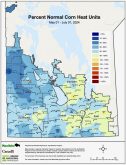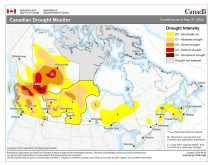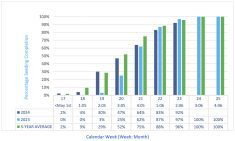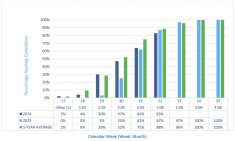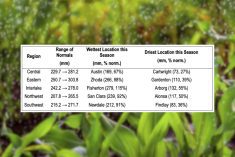Overview
Harvest progress sits at 63 per cent completed across the province, approximately 3 weeks behind the 5-year average of 86 per cent complete by week 40.
The past week had a substantial increase in harvested canola area, with over 1.9 million acres now off the field. This brings the canola harvest from 30 to 58 per cent, or an increase of approximately 925,000 acres.
Read Also
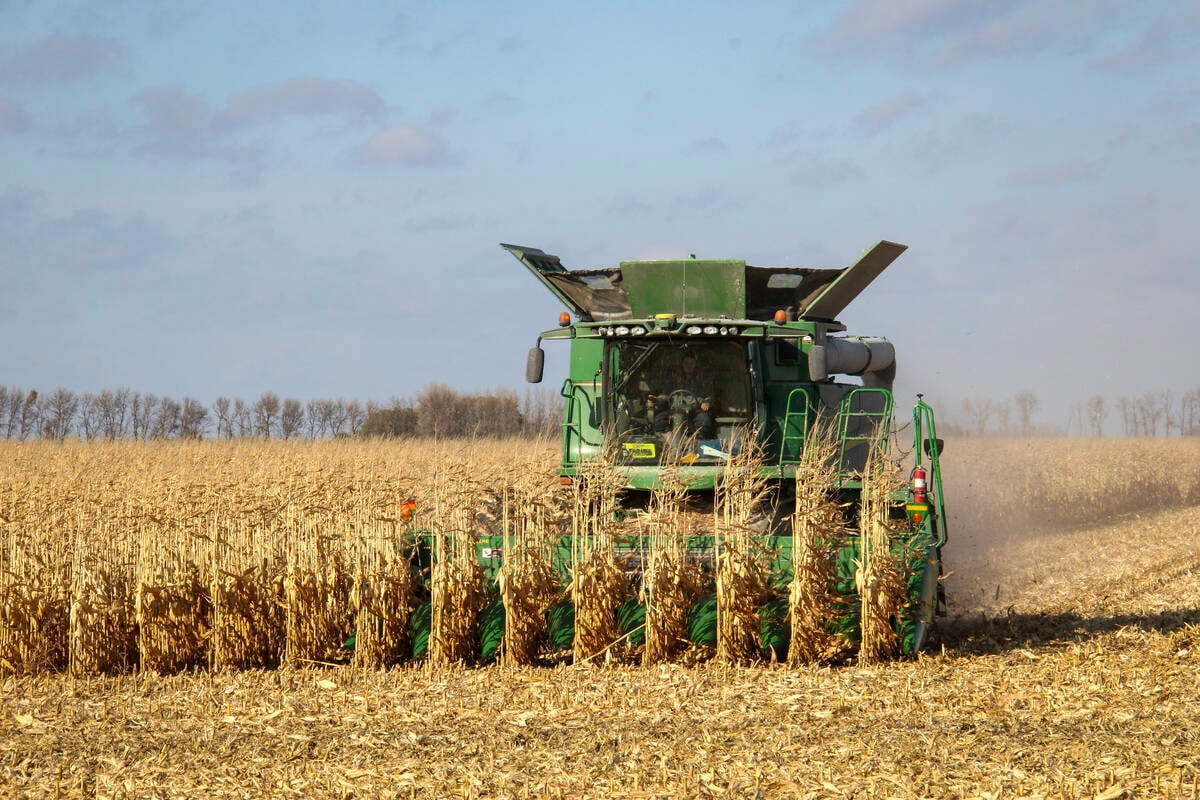
Manitoba corn research looks for home-based weed control
University of Manitoba researchers want corn growers to have Manitoba-based weed control advice, not U.S. or Ontario-based recommendations.
Soybean harvest has started, as farms wrap up cereals and canola. Yields reported to date range from average to above-average.
Some unharvested cereals have seen quality downgrading from recent wet weather, where staining, mildew and sprouting has affected late wheat and oat crops.
Fall tillage and fieldwork is underway wherever farmers are caught up with harvest, or are able to work when rains stop harvest progress. Harrowing stubble is common, and some fall broadcast fertilizer is being applied, together with a start to anhydrous ammonia banding.
Cereals
Spring cereal grains
Better drying weather in recent days has allowed resumption of cereal harvest.
Some wheat crops harvested after the rains have been downgraded to No 3 CWRS as a result of mildew and sprouting, while most remain a No 2 CWRS.
Swathing yet-unharvested crops is much more common across the province this year, in an effort to reduce green straw problems and increase combine speed and efficiency.
In oats, growers are making the decision to swath late fields and are dealing with increased shelling losses.
Oats lying in swath for several weeks have stained, some sprouting is occurring, but grain remains
marketable.
Corn
Corn is drying down after a killing frosts last week.
Frosts have burned leaves in corn crops. Seed moisture is generally between 25 to 35 per cent.
Silage-making is ongoing in all regions.
Oilseeds
Canola
Canola crops are drying slowly following wet weather, and many crops have been harvested tough to damp, and require supplemental drying or aeration.
Direct-cut canola has been tougher than swathed canola, and straw distribution has been uneven behind the combine.
Average yields vary, with a 20 to 60 bu/acre spread across much of the province.
Canola yields are trending higher in the Central region to the low fifties. In the Northwest, early yields are below average, between 40 to 45 bu/acre. Canola in the Southwest is averaging 43 bu/acre.
Interlake canola yields have been disappointing for many, between 30 to 40 bu/acre. Lygus bug damage is showing up in some canola samples, and being downgraded to a No 2 Canada.
Flax & sunflowers
Many flax crops are now in swath; the remainder of the crop remains standing for direct harvest. Some limited harvest has started in the southern parts of the province.
Sunflowers have reached R9, chemical desiccation is nearly complete in the Eastern, Central and Interlake regions, while others may rely on natural desiccation to advance crop drydown.
Blackbirds are becoming a pest on ripe sunflower crops, farms are hoping to start harvest as soon as logistics and weather allow.
Pulses
Soybeans
Soybean harvest has started in many areas. Early-seeded crops in the Southwest appear to have better yields than later crops, while in the Central region, longer-season varieties are yielding better.
Many parts of the Central region have seen a good start to soybean harvest, early yield reports are between 40 to 50 bu/acre, while long-season soybeans are yielding 50 to 60 bu/acre.
Soybean harvest is just starting in the Northwest, in the Swan Valley and surrounding Dauphin. Yields vary widely, from 20 to 60 bu/acre.
Dry edible beans
Dry bean harvest is approaching 80% complete. Very good yields reported, with many bean classes yielding between 2,000 to 3,000 lbs/acre.
The record average yield for dry beans in Manitoba was set in 2017 at just over 2,100 lbs/acre, and dry bean crops could exceed that mark this year.
Forages & livestock
Forages
Grass hay and alfalfa has become dormant. Pastures have enough fodder to allow animals to graze for a short time longer.
Corn silage harvest is underway in many areas, tonnage appears to be good.
Silage corn is drying down rapidly, silage crews are forced to move quickly to keep up with the correct
moisture level.
Retrieval and removal of hay and straw bales is underway.
Livestock
Dugouts and sloughs are at 50 per cent capacity in the Southwest, and remain sufficient elsewhere in the province.
Livestock water supplies on pasture are dropping, but remain sufficient to complete the grazing season in all parts of the province.
Fall cattle roundup from community pastures has begun; mostly yearlings and earlier calves are moving to the auction marts at this time.
Regional comments
Southwest
Last week started out well for harvest progress, with most producers getting back in the field, and grain moisture was dry or very close. Later in the week harvest became more difficult as humidity levels increased and harvesting hours decreased. Producers are having problems with getting standing canola to dry. A few showers in some areas also hindered harvesting mid-week. Heavy fog and dew contributed to increased moisture percentage in the standing crops.
Northwest
Warm temperatures and drying winds contributed to a good week of harvest progress. A small thunderstorm through parts of the region, slowing harvest mid-week, but harvest was able to resume fairly quickly. A light frost touched down in some areas this morning.
Central
Improved drying weather arrived towards the middle of last week, when humidity dropped and warm, steady winds allowed standing and swathed crop to dry. Humid overnight conditions meant that harvest resumption the following day was often delayed until after noon. Canola in particular was noted as ‘reabsorbing’ moisture towards the end of the day, and frequently had to be put on aeration or artificially dried in some cases. Fall tillage is underway where producers are caught up to harvest, or are preparing ground while they wait for the crop to dry each day. A limited start to grain corn has begun, but no yields reported to date.
Eastern
Favourable weather allowed for significant harvest and haying progress in the region this past week. Beginning last Tuesday, combines began harvesting any crop that was accessible. Farmers are using aeration systems and grain dryers whenever grain moisture is tough or damp, in an effort to speed harvest. With shorter daylight hours, small rains are having large impacts on fieldwork and harvest as this late harvest moves into October.
Interlake
Good harvest progress was achieved last week, with many crops harvested tough. Farmers are using natural aeration and supplemental grain drying to condition grain to safe storage levels. Successive weeks of wet weather has decreased crop quality, with some reports of mildew and sprouting in wheat, but most deliveries have been graded 2 CWRS. Mildewed samples have been grading 3 CWRS. Green straw continues to be a problem for harvest in the region, reducing harvest capacity and speed.




